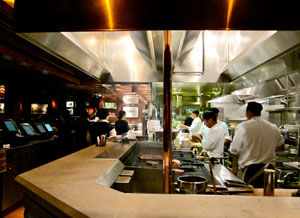
Making sure that your restaurant has a high-quality commercial kitchen exhaust hood system is far more important than many people realize. A kitchen exhaust hood will keep your restaurant safe from the risk of fire and clean. Once installed, a commercial kitchen ventilation system will capture any grease and vapors coming off of your grill and bring them through the ventilation system’s ductwork to be deposited outside. Removing the grease from the air in a commercial kitchen will help make your restaurant’s kitchen and dining area much more comfortable and significantly lower the risk of a commercial kitchen fire.
Commercial kitchen ventilation systems typically is made up of an exhaust hood, ductwork, fan system and a source of makeup air. The whole system will work together to make your establishment fire safe and compliant with city fire codes.
Exhaust hoods are the component of the kitchen ventilation system that initially captures the grease coming from your grill. The most common type of hood looks like a large box with an opening on the bottom where it captures the air coming off the grill. There are many types of exhaust hoods available to meet the specific needs of different restaurants but most fit into 1 of 2 categories.
- Type 1 exhaust hoods are designed to handle grease and have a number of additional components beneath the hood.
- Type 2 exhaust hoods are able to collect steam, vapor, heat and odors but not grease.
The ductwork of the system is how the contaminated air being collected is transferred out of your kitchen. Ducts are made of stainless steel and must be supported by non-combustible bracing to comply with fire code.
The contaminated air is moved through the ventilation system’s ductwork by the ventilation fan system. It is important that the system’s fan is easily accessible so it can be cleaned and inspected. There are a few different types of fans so you can find one that meets the needs of your restaurant.
- Up-blast fans are designed for being mounted on the roof directly above the exhaust stack.
- Utility fans are normally installed on the roof and have inlet and outlet points that are 90 degrees apart.
- Inline fans can be installed in the interior duct and normally used when access to the roof is impractical.
The last component of the system is the source of make-up air. Make-up air is required to replace the air removed through the ventilation system. Having an adequate source of make-up air is essential to the commercial kitchen ventilation system working correctly.
 CS Ventilation | Commercial Kitchen Hood Cleaning
CS Ventilation | Commercial Kitchen Hood Cleaning